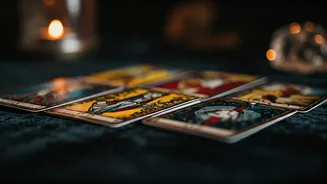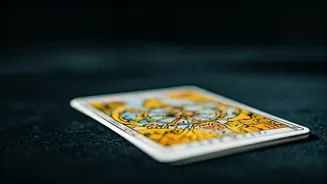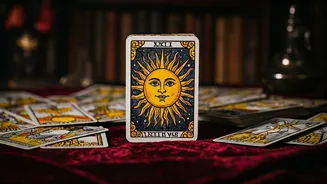Origins of Tarot
The origins of Tarot cards are shrouded in mystery, with their roots stretching back to 15th-century Europe. Initially, these cards weren't used for divination;
instead, they were part of card games like Tarocchi. Over time, the cards evolved, incorporating esoteric and symbolic elements. The earliest decks consisted of ornate illustrations, including suits of coins, cups, swords, and wands, along with a set of trump cards representing significant life themes. This gradual shift saw the cards transcend mere entertainment, becoming tools for self-discovery and spiritual exploration. Their evolution reveals a fascinating history, combining playfulness with profound symbolism.
Major Arcana Explained
The Major Arcana forms the core of the Tarot deck, comprising 22 cards, each representing a profound life lesson or archetype. These cards, such as The Fool, The Magician, The High Priestess, and The Lovers, depict pivotal stages and influences in human experience. The Fool signifies new beginnings and potential, the Magician embodies skill and resourcefulness, and the High Priestess represents intuition and hidden knowledge. Each card holds a unique symbolism, offering guidance on navigating life's complexities. The Major Arcana provides a roadmap, allowing individuals to interpret their life's journey with deeper awareness, from embarking on adventures to recognizing the bonds of love, leading towards a more profound understanding of their unique path.
Minor Arcana Details
The Minor Arcana complements the Major Arcana, consisting of 56 cards divided into four suits: Wands, Cups, Swords, and Pentacles (or Coins). Each suit represents different aspects of life: Wands symbolize action and passion; Cups, emotions and relationships; Swords, intellect and challenges; and Pentacles, material possessions and security. Every suit is filled with ten numbered cards and four court cards (Page, Knight, Queen, and King), each symbolizing distinct aspects of everyday experience. The Minor Arcana, along with the numbered cards and court cards, provide detailed insights into everyday scenarios, offering guidance on navigating relationships, facing challenges, and recognizing opportunities, leading to enhanced self-awareness.
Reading the Tarot
Conducting a Tarot reading involves a combination of intuition and knowledge of the cards' symbolism. The process usually begins with the querent (the person asking the questions) focusing on their query. The reader then shuffles the deck, allowing the querent to cut it. A specific layout or spread is then selected, such as a three-card spread for a quick overview or a more detailed Celtic Cross spread. Each position in the spread represents a different aspect of the question. The reader draws the cards and interprets them in relation to the question, using their understanding of the symbolism. This technique aims to provide insights, guidance, and a clearer perspective on the situation at hand.
Common Tarot Spreads
Various Tarot spreads suit different types of questions. The Three-Card Spread is a straightforward choice, offering a quick overview of the past, present, and future or the situation, challenge, and advice. The Celtic Cross Spread is a complex layout, providing a holistic perspective on an issue. It uses ten cards to cover the querent's situation, challenges, influences, and potential outcomes. Other spreads include the Horseshoe spread for simple inquiries and the Relationship Spread for insights into relationships. Selecting the right spread depends on the complexity of the question and the depth of understanding sought. By using these layouts, the reader can offer tailored insights and guidance, enabling a more informed approach to life's challenges.
Interpreting Card Meanings
Interpreting Tarot card meanings involves more than just memorizing definitions; it relies on intuitive insights and understanding of the cards' symbolism within the context of the question. Each card carries a range of interpretations; these meanings can change based on the card's position in the spread and its relationship with surrounding cards. The reader should be open to understanding the intuitive messages that come, as well as the standard meanings of the card. A good reader can connect with the querent's energy and the card's symbolism, allowing the cards to share pertinent insights and advice. The interpretations should be clear, concise, and focused on the querent's questions, providing clarity and guidance.
Ethical Considerations
Responsible Tarot reading involves ethical considerations. A key principle is approaching the cards with respect and sincerity. The reader should avoid manipulating or predicting negative outcomes to the querent. Focusing on providing guidance and support rather than dictating a rigid path is crucial. It’s important to respect the querent's autonomy and encourage them to make their own choices. Keeping the readings confidential is also vital, respecting the querent's privacy and building trust. Ethical practice makes Tarot a valuable tool for self-reflection and empowerment. By observing these guidelines, readers promote a positive and supportive experience, inspiring trust and building a constructive relationship with clients.
Tarot and Self-Reflection
Tarot cards serve as powerful tools for self-reflection and introspection. Reading the cards helps to explore inner emotions, gain insights into the subconscious, and recognize patterns in life. Through the symbols and narratives of the cards, individuals learn to understand their strengths, weaknesses, and potential. The Tarot also promotes mindfulness and provides a space for exploring personal growth. By reflecting on the card's meaning, individuals can discover hidden truths, challenge limiting beliefs, and cultivate a deeper understanding of themselves. Consistent use of Tarot as a self-reflection tool encourages empowerment and supports a more authentic and balanced existence. It fosters an inner journey towards greater self-awareness and personal evolution.
Tarot for Beginners
Starting with Tarot can be a rewarding journey. Beginners should select a deck they feel drawn to, which can have an impact on the reading. Start with small steps: learn the cards one by one, focusing on their basic meanings, and noting how they make you feel. Practice with simple spreads, like the one-card or three-card spreads, to build confidence and develop intuition. Keeping a Tarot journal helps you record your interpretations and insights. You should always read the cards in context to understand the cards in relation to the spread and your question. Practice consistently to sharpen your intuitive skills and create a deeper connection with the cards. Embrace the learning process, and enjoy the adventure of discovering the wisdom contained within the cards.







